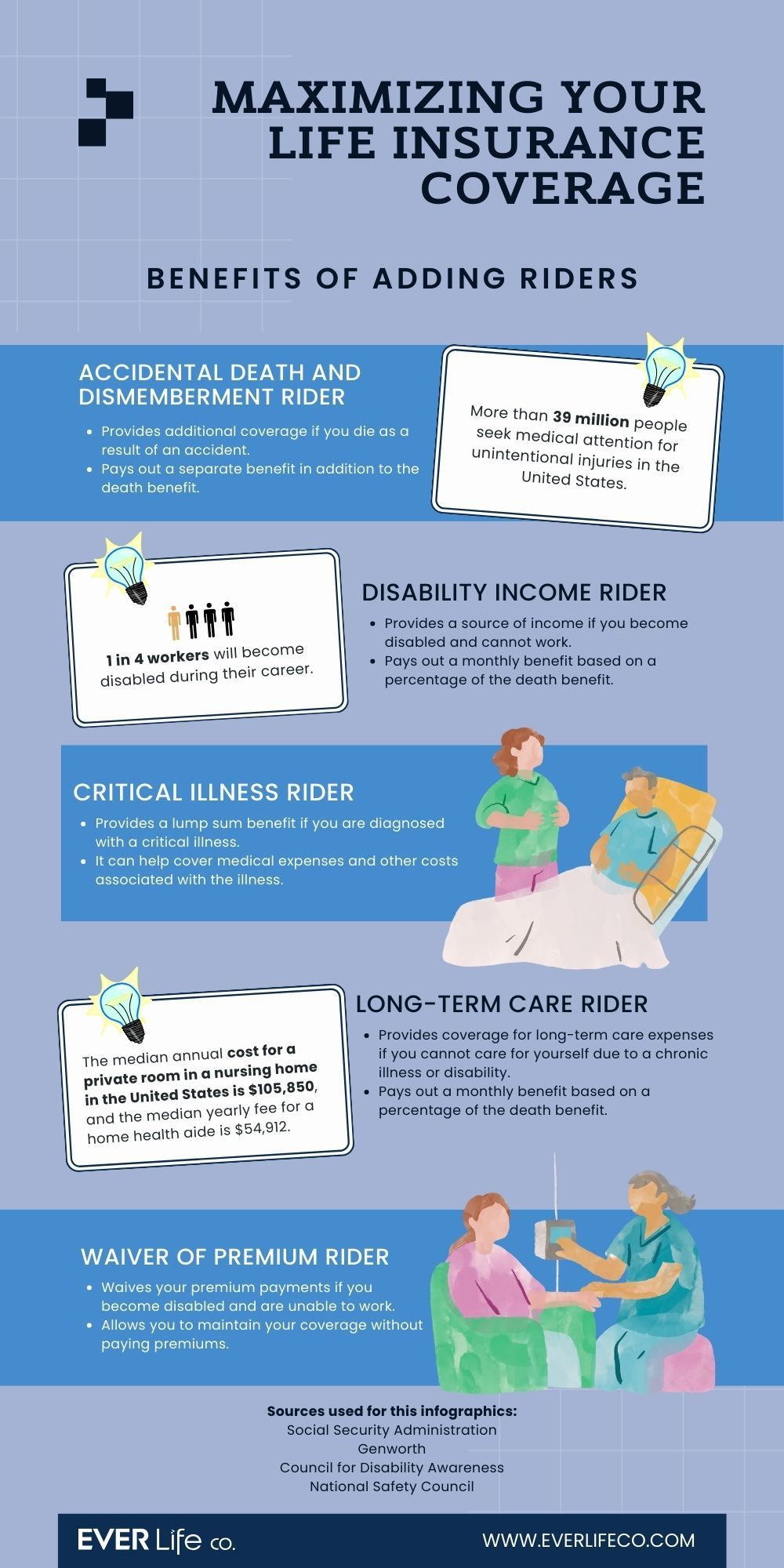No single policy fits all with life insurance. While a basic life insurance policy provides a death benefit to your beneficiaries, it may not always fully address your specific coverage needs. This gap is what life insurance riders bridge to bolster your financial protection.
There’s a long list of available insurance riders. Each presents unique benefits for different life situations. Whether you’re a new life policy policyholder or you’ve had coverage for years, this post will help you understand how riders can help you unlock the most out of your policy.
What Is a Life Insurance Rider?
Life insurance riders are add-on benefits purchasable with a base life insurance policy for additional coverage in specific situations. Insurers designed these riders for an added layer of customization to tailor your policy according to your particular needs and circumstances.
For example, one popular life insurance rider is the accidental death and dismemberment (AD&D) rider, which provides additional coverage if the policyholder dies or loses a limb due to an accident. Other examples of riders include long-term care riders, waiver of premium riders, and child-term riders.
The flexibility and control riders provide come at an extra cost, but it’s worth it if you want custom-made coverage. Ensure you understand what each rider covers and any terms and conditions that may apply before adding one to your policy.
Don't be talked into buying unnecessary add-ons by your life insurance agent. Choose the riders that best suit you, and if you don't need them, leave them off.
Types of Life Insurance Riders
Policyholders can add several types of life insurance riders to their life insurance policies. Let’s explore some of the most popular riders.
Accidental Death and Dismemberment (AD&D) Rider
An Accidental Death and Dismemberment (AD&D) Rider offers additional coverage if the policyholder dies or suffers a significant injury due to an accident. This rider doubles the life insurance payout, with the added amount equaling the original policy’s face value. Because of this “doubling,” the rider has a second name—Double Indemnity Rider.
If you’re your family’s sole or primary provider, an AD&D rider is a valuable addition to your life insurance policy. With the double benefit, your surviving family members will be financially secure and able to cover expenses.
Restrictions may apply to an AD&D rider as insurers often limit the definition of “accident.” Ensure you understand the meaning of “accident” as specified by the life insurance company and be aware of any limitations on the rider.
Long-Term Care (LTC) Rider
The U.S. Department of Health and Human Services estimates that 70% of people over age 65 will require some form of long-term care in their lifetime. A long-term care insurance rider is an add-on to your life policy for additional coverage if you need long-term care services. These covered expenses can include the following:
- Help with activities of daily living tasks (ADLs): bathing, dressing, and eating, as well as custodial care and skilled nursing services
- Assisted living, in-home care, and nursing home care
- Physical therapy
- Home health aides
- Medical supplies
You’ll gain access to funds from your policy to pay for long-term care expenses. Adding this rider to a life insurance policy is more cost-effective than purchasing a separate long-term care insurance policy.
Accessing funds from the death benefit will reduce the money beneficiaries receive.
The additional cost of long-term care riders varies by company. Still, it usually costs several hundreds of dollars in monthly premiums. The high-cost offsets the financial risk insurers face with costly claims.
Waiver of Premium Rider
The waiver of premium rider offers a solution for policyholders who become permanently disabled or lose their income due to injury or illness before reaching a specified age. In these circumstances, the primary breadwinner’s disability can significantly strain a family. The waiver of premium rider exempts policyholders from paying future premiums without losing coverage.
This rider is beneficial when the policy’s premium is high. However, it’s crucial to know that the definition of “disabled” will vary between insurance companies. Before adding a waiver of premium rider to your life insurance coverage, ensure you understand the specific terms and conditions offered by your insurer.
Child Term Rider
A child term rider provides coverage for the policyholder’s children. The rider is usually added to a parent’s life insurance policy and provides a death benefit if the child passes away during the policy term.
The child term rider typically covers children until they reach a certain age, such as 18 or 21, when they can obtain a separate permanent life insurance policy. Although this rider increases your premium payment, child riders are generally inexpensive because of the expected life expectancy of the child.
Covered expenses with this rider coverage include funeral costs and medical bills.
Accelerated Death Benefit Rider (Living Benefit Rider)
With an accelerated death benefit rider, the insured can access a portion of their death benefit if diagnosed with a terminal illness, significantly reducing their life expectancy. Typically, insurance companies provide a percentage of the death benefit from the base policy to the insured person.
The insurer may deduct the amount received from a claim and interest from the final payment of benefits beneficiaries receive. This rider is usually available at a low cost or even no cost. However, the definition of “terminal illness” may vary among insurance companies. Before purchasing the rider, it’s essential to review the specific coverage terms.
Critical Illness Rider
With a critical illness rider, the insurance company will pay out a portion of the death benefit if the policyholder is diagnosed with one of the illnesses specified in the rider. Any funds used in advance under this rider will reduce the death benefit money payable to the policyholder’s beneficiaries.
Unlike the accelerated death benefit, the illnesses covered under a critical illness rider are not necessarily terminal. Still, these illnesses, such as cancer, stroke, or kidney failure, significantly impact the policyholder’s life expectancy.
Guaranteed Insurability Rider
With a guaranteed insurability rider, you can purchase additional life insurance coverage during a specified period without undergoing a medical examination. This type of rider is beneficial when you experience significant changes in your life, such as the birth of a child, getting married, or a rise in income.
Even if your health deteriorates with age, you can still apply for additional insurance coverage without providing evidence of insurability. In addition, this rider also allows you to renew your base policy at the end of its term without needing a medical check-up. A cutoff age may apply.
The coverage, premium rates, terms, and conditions of guaranteed insurability riders vary from one insurance company to another. Additionally, claiming the benefits of a rider can result in the insurer terminating the rider, while the base policy will continue to provide coverage.
Return of Premium Rider
With a return of premium rider, your insurer will refund all of the premiums paid into the policy if the policyholder outlives the policy’s term. This rider is suitable for individuals looking for life insurance coverage, but they worry about the possibility of not using the death benefit.
Like any other rider, adding a return of premium to your policy will increase your monthly payments, so consider the cost versus the potential benefits before buying. Carefully review the terms and conditions of any return of premium rider you are considering, as some return of premium riders only return a share of the premiums paid into the policy.
Term Conversion Rider
A conversion rider allows you to convert your term life policy into a whole or permanent insurance policy. This option may be built into the term policy or added as a separate rider. Conversion has no additional underwriting requirements, and the timing and duration will vary.
This rider is ideal for those who may still be financially responsible for dependents after the term life insurance ends and want to secure their continued protection. Or for those who wish to access the cash value components of a whole life policy in the future.
Other Options for Extra Life Insurance Coverage
The above list covered some of the top coverage options. Here are some additional riders you can consider.
- Spouse Life Insurance Rider
- Family Income Benefit Rider
- Cost of Living Rider
- Disability Life Insurance Rider
- Early/Enhanced Cash Value Rider
- Estate Protection Rider
- Lapse Protection Rider
- Overloan Protection Rider
- Transfer of Insured Rider
- Yearly Renewable Term Rider
The availability of riders depends on the policy type, so ask your agent about the options that best suit you.

Conclusion
Life insurance policy riders are the perfect option if you’re looking for ways to tailor and enhance your policy. They provide much-needed financial security and peace of mind for you and your loved ones. Riders typically come at an extra charge, but it’s worth it. You can customize your life policy with the right rider to fit your lifestyle and budget.
Whether you’re looking for additional protection against accidental death, long-term care expenses, a way to ensure you’re covered as your family grows, or upgrading your term life policy into a whole life policy, there’s a rider available to meet your needs.
Before deciding on a rider, ensure you understand what it covers, any applicable terms and conditions, and the associated cost. Life insurance riders can be invaluable assets as you plan for your family’s future.






